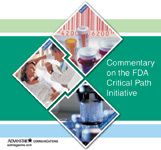FDA: Taking the Initiative
Applied Clinical Trials
The Critical Path Initiative (CPI), as it has come to be called, provided the FDA's analysis of the current drug development pipeline problem, characterized by a recent slowdown-instead of the expected acceleration-in innovative medical therapies reaching patients.
On March 16, 2004, the Food and Drug Administration (FDA) issued a position paper entitled: "Innovation or Stagnation...Challenge and Opportunity on the Critical Path to New Medical Products." The Critical Path Initiative (CPI), as it has come to be called, provided the FDA's analysis of the current drug development pipeline problem, characterized by a recent slowdown—instead of the expected acceleration—in innovative medical therapies reaching patients. The basic tenet of the FDA's analysis is that the applied sciences needed for medical product development have not kept pace with the tremendous advances in the basic sciences. Often, product development programs must be abandoned late into the development stage after extensive investment of time and resources. The path to market even for successful candidates is long, costly, and inefficient, due in large part to the current reliance on assessment methods for safety and efficacy that lack appropriate sensitivity and specificity that is then made up for by the ever-increasing size and duration of clinical studies.

James P. Burns, Jr., PhD, and Gregory M. Hockel, PhD, PharmaNet
The answer, according to the FDA, is a new product development "toolkit," containing powerful new scientific and technical methods, including the use of biomarkers for safety and effectiveness, to improve predictability and efficiency along the critical path from laboratory concept to commercial product.
Although it is clear the CPI would extend the use of biomarkers beyond its current use for indications that are serious or life-threatening, there has been limited success with the use of biomarkers, or surrogate markers, outside of oncology and cardiovascular indications. Furthermore, the FDA has required fairly extensive "validation" trials that correlate the changes in a biomarker with a hard clinical endpoint. Many pharmaceutical manufacturers have therefore been reluctant to embrace the use of biomarkers and/or surrogate endpoints in the conduct of studies to support product approval given the FDA's previous strict requirements for their use for product approval.
Beyond biomarkers
In addition to the use of biomarkers, the CPI identifies, rightly so, other development needs that are on the critical path, such as the use of technology for the assessment of drug safety and manufacturing issues. The FDA also advocates the combined efforts of academic and industry resources to address the issues in the CPI (although industry's interest in participating has already been questioned).

A perceived weakness of the CPI is a lack of involvement of other regulatory authorities in its development. Without concurrence of the such authorities and the other members of the International Conference on Harmonization (ICH), development programs based on the CPI may not lead to approval in other global markets. Given the current trend to conduct drug development programs that will lead to global marketing, industry might not view the CPI as helpful.
The impact of the CPI on the contract research industry (CROs) is still to be determined. The FDA, most notably through Dr. Janet Woodcock, has been a strong and vocal proponent of the CPI and hopes that the use of some or all of the developmental improvements noted will lead to faster, more efficient product development. This will benefit industry by providing more defined but less costly requirements to support product approval, but more importantly, will get important new therapeutic entities to patients more quickly, thereby helping the FDA fulfill its role in improving public health.
The pharmaceutical industry is taking a "wait and see" attitude regarding many of the elements of the CPI, but it also is making sure it can take advantage of any possible new regulatory opportunities through research into the future use of biomarkers and surrogate endpoints. This has created new opportunities for CROs who have been working in the bioanalytical and early clinical development areas, as this is where most of the action is at the moment. Should this research bear fruit, there is clearly an opportunity for any CRO who can provide services that reflect the needs of the CPI. This will require a CRO with a high level of technical competence as the new developmental arena will be much more science-based, requiring knowledge of such areas as biomarkers and pharmacogenomics.
It is encouraging that the FDA is taking the lead. Hopefully, this will lead to the earlier and more efficient development of innovative new therapies. However, it is unclear if the initiative, albeit still in its "early days," will accomplish its goals unless the initiative gets the full support and participation of industry and extends the initiative globally by including members of ICH.

FDA Fast Tracks Johnson & Johnson’s Nipocalimab for Fetal Neonatal Alloimmune Thrombocytopenia
March 27th 2024Johnson & Johnson is moving forward with a pair of Phase III trials of nipocalimab to reduce the risk of fetal neonatal alloimmune thrombocytopenia in alloimmunized pregnant patients.